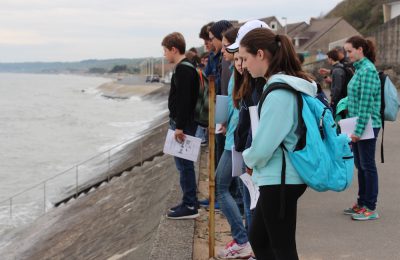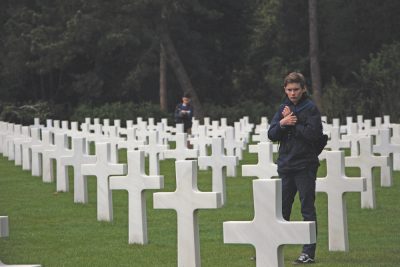
Grade 8 students went on an exciting trip to Normandy, France to go more in depth with their World War II study. They left on May 8, and returned to ASL on May 12 via coaches. The trip was primarily social studies focused, although it incorporated aspects of other subjects as well, to give it more of a balance for the culminating trip of the year.
Due to the extensive study of World War II, students spent three days visiting places in Normandy which would help them enrich their learning about the war, and specifically D-Day. These places included Utah, Omaha, Juno, Gold, and Sword beaches as well as the Mulberry Harbors. The Caen Peace Museum, the Airborne Troops Museum at Sainte-Mère-Église, Pointe du Hoc, and Pegasus Bridge allowed the students to understand more about what they were learning and have a more hands-on approach on how the war played out. Pupils were also taken to numerous gun batteries and bunkers to give them some point of view of what the soldiers may have actually seen. They were also allowed to have dinner by themselves in Caen and Honfleur on specific nights throughout the trip.
In order to analyze how different cultures commemorate their dead, students were brought to La Cambe German War Cemetery, the US Military Cemetery, and the British and Commonwealth Cemetery at Bayeux. “…the graveyards just felt like headstones in rows, but after actually meeting live people who fought, it made them not only more significant, but I wish I could do more to honor them than just a headstone,” said eighth grader Russell Cornelius, when speaking of the great impact seeing veterans at the British Commonwealth Cemetery made on him. Eighth grader Anna Kopfler felt that seeing the Veterans brought everything they had learned that week to life and the entire experience made her more grateful for everything that she has. Students also paid a visit to Arromanches where they watched a short World War II film in a 360 cinema. Each group of students was given a tour guide to explain what they were seeing throughout the trip, and help them understand the information in more depth.

The trip was divided into three days, Day A, B and C, which gave a schedule of what the students would be visiting on that day, and certain places the students would see. The grade was split into three different bus groups as well, so each group would have either Day A, B, or C as their schedule of what they would be visiting. By the end of the trip, all students had visited the same sites, just in a different order.
Before embarking on their trip, each student was given a Normandy journal, with activities and assignment to complete for each day. The journal included places to take notes, sketch drawings of what students saw, and write reflections. Students were required to choose a topic on World War II which interested them, and they were expected to do research on that subject before, during, and after Normandy for their final social studies paper. The journal was especially helpful to jot down notes about the chosen subject, and to have more information for students’ upcoming papers. There were also aspects of the journal which allowed students to work on other subjects, such as science or world language.
Although the trip was educational, there were also many opportunities for students to explore the towns the group stopped at along the way, and practice their French or try the food of that town. There was also a day where the groups stopped at an apple cider farm and were able to learn how they made their cider and juices, and buy some goods.
Overall, the trip provided a great way for students to learn and have fun at the same time.
